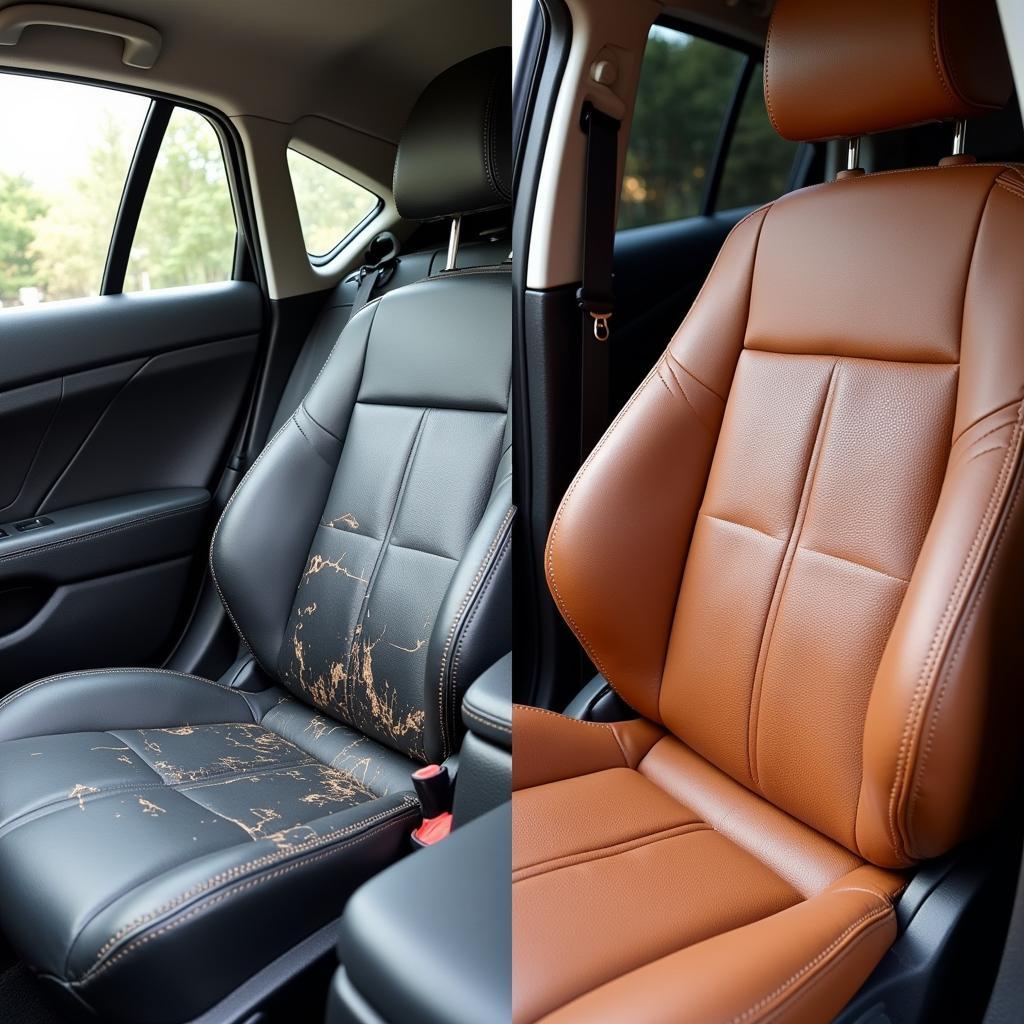Leather car seats instantly elevate a vehicle’s interior, offering a luxurious feel and unmatched comfort. However, time and use can take a toll, leading to unsightly cracks, scratches, and fading. A quality leather repair car seat kit empowers you to combat these blemishes and restore your car’s interior to its former glory.
Understanding Leather Repair: Is a Kit Right for You?
Before diving into the world of leather repair car seat kits, it’s crucial to understand what they offer and if they suit your needs. These kits, readily available online and at auto parts stores, typically include:
- Cleaning agents: Formulated to remove dirt, grime, and debris without harming the leather.
- Fillers: Used to repair cracks, tears, and holes, providing a smooth surface for color restoration.
- Color matching compounds: Designed to blend seamlessly with your existing leather color, effectively masking imperfections.
- Finishing products: These seal and protect the repaired area, enhancing durability and preventing future damage.
A leather repair car seat kit is an excellent option if you’re dealing with minor to moderate damage, such as:
- Surface scratches and scuffs
- Small cracks and tears
- Color fading and discoloration
However, for extensive damage involving deep tears, significant structural issues, or extensive panel replacements, seeking professional upholstery repair is recommended.
Choosing the Right Leather Repair Car Seat Kit
The effectiveness of your repair hinges on choosing the right kit for your specific needs. Here’s a breakdown of crucial factors to consider:
1. Leather Type: Identify the type of leather in your car. Kits are often tailored for specific leather types, such as pigmented, aniline, or Nappa leather. Using the incorrect kit can lead to unsatisfactory results.
2. Color Matching: Achieving a seamless repair relies heavily on accurate color matching. Some kits offer pre-mixed colors, while others provide mixing pigments for a truly custom match. Carefully compare the kit’s color options to your car’s leather.
3. Damage Severity: Assess the level of damage on your car seats. Kits are designed for specific damage levels, with some catering to minor imperfections and others equipped for more significant repairs.
4. Kit Contents: Examine the components included in each kit. Some kits provide a comprehensive set of tools and materials, while others require you to purchase additional items separately.
5. Reviews and Ratings: Before making a purchase, research and read reviews from other customers. This provides valuable insights into the kit’s performance, ease of use, and overall satisfaction.
best leather seat repair kit for cars
DIY Leather Car Seat Repair: A Step-by-Step Guide
Tackling a DIY leather repair project might seem daunting, but with the right approach and a reliable car leather seat repair kit, you can achieve professional-looking results. Here’s a comprehensive guide to walk you through the process:
1. Preparation is Key: Begin by thoroughly cleaning the affected area with a leather cleaner. This removes dirt and grime, ensuring optimal adhesion of the repair materials. Allow the area to dry completely before proceeding.
2. Addressing Cracks and Tears: For minor cracks, apply a leather filler using a palette knife or a similar tool. Gently press the filler into the crack, ensuring a smooth and even surface. For larger tears, consider using a leather patch, adhering it with leather adhesive and following the manufacturer’s instructions.
3. Color Restoration: Once the filler or patch is dry, it’s time to address color loss. Using a matching color compound from your kit, apply thin, even coats to the repaired area. Allow each coat to dry completely before applying the next.
4. Blending and Finishing: Gently blend the edges of the color compound into the surrounding leather using a soft cloth or sponge. This creates a seamless transition and a natural-looking finish.
5. Sealing and Protecting: To protect your handiwork and prevent future damage, apply a leather sealant or conditioner. This final step provides a protective barrier against dirt, UV rays, and everyday wear and tear.
Expert Insights: Tips for Success
“One common mistake people make is rushing the drying process,” shares John Miller, a seasoned automotive upholstery specialist. “Allow ample drying time between each step—cleaning, filling, coloring, and sealing. This ensures optimal adhesion and a long-lasting repair.”
“Don’t underestimate the importance of color matching,” adds Miller. “Take your time to find the closest match to your leather. A slight color difference can be glaringly obvious, compromising the entire repair.”
Beyond Repairs: Maintaining Your Leather Car Seats
While a leather repair car seat kit effectively addresses damage, preventative measures significantly extend the life and beauty of your leather car seats.
-
Regular Cleaning: Establish a routine of cleaning your leather seats every few weeks using a dedicated leather cleaner. This prevents dirt and grime from settling into the leather’s pores.
-
Conditioning is Crucial: Leather, like skin, needs hydration. Apply a leather conditioner every few months to keep it supple and prevent drying and cracking.
-
UV Protection: Prolonged sun exposure can fade and damage leather. Use a sunshade when parking outdoors or consider tinted windows to minimize UV damage.
Leather Repair Car Seat Kit: FAQs
Q: Can I use a leather repair car seat kit on any type of leather?
A: Leather repair car seat kits are often formulated for specific leather types. It’s crucial to identify your car’s leather type and choose a kit specifically designed for it.
Q: How long does a leather repair typically last?
A: With proper care and maintenance, a well-executed leather repair can last for several years. However, factors like usage, climate, and cleaning habits can impact the repair’s longevity.
Q: Can I use a leather repair car seat kit on other leather goods?
A: While some kits are marketed for general leather repair, it’s best to choose a kit specifically designed for car seats. Car seat leather often has unique properties and endures specific wear patterns.
Conclusion
Maintaining the luxurious appeal of your car’s leather interior doesn’t have to involve costly professional repairs. A leather car seat repair kit empowers you to address minor to moderate damage effectively, restoring your car’s interior to its former glory. By following the steps outlined in this guide and heeding expert advice, you can confidently tackle DIY leather repair projects, saving money and enjoying the satisfaction of a job well done.
Remember, when in doubt or dealing with extensive damage, seeking professional assistance is always recommended.



